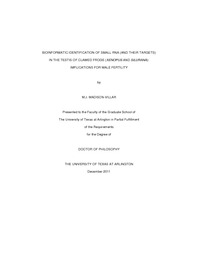| dc.description.abstract | Chapter one sets the stage for this project, which lies somewhere near the intersection of speciation, genome, and reproductive biology. Chapter two identifies miRNA with shared expression profiles (Silurana and Xenopus). These miRNA are pulled from a subset that has retained testis expression despite a hybridization induced WGD event early in the Xenopus lineage (~21-41 MYA). Allopolyploidization is a revolutionary mechanism of genome evolution, and this event should have afforded an opportunity for diversification and changes in the expression of what are generally highly conserved transcript regulators. It is inferred that the miRNA identified in this study retained testis expression due to strict selection, and that their targets should participate in key pathways, such as those that would ensure reproductive potential. This chapter moves on to identify the most likely targets of these miRNA, and then investigates their fates following WGD. Given the expectation of widespread genome disruption following allopolyploidization, it is hypothesizes that the miRNA targets (kdm2a, map3k9, kif23, smarca4, clasp1, eed, nob1, and abcb1) will, if retained, show evidence of sub/neofunctionalization. Most targets are clearly associated with fertility, and several are associated with early embryogenesis. This latter association suggests a possible role for male mediated miRNA outside of the male germline, where they may help to facilitate fertilization and/or help regulate maternally deposited mRNA.Chapter three identifies a subset of testis expressed miRNA that are misexpressed in the sterile hybrids, and associates these with miRNA known from the testis of mammals. This chapter proposes a subset of miRNA that may have a conserved role in ensuring male reproductive potential in all of vertebrates; it is currently in press with the Journal of Molecular Evolution.Chapter four investigates pachytene expressed pilRNA (PIWI-like RNA), and how the repeat and non-repeat subpopulations respond to hybridization. Part one describes the repeat associated population (rapilRNA): relative abundance, which transposable elements (TEs) they are associated with, how they map to both Class I and Class II elements, and which DNA strand they are derived from. Part two investigates the response of rapilRNA to hybridization: fold change between hybrids and parental taxa is quantified, and ping-pong amplification is considered, but rejected. Part three identifies misexpressed pilRNA from those having homology to previously identified piRNA, possible targets are identified, and the roles of these targets in male reproduction are investigated. Many of these recover association with SUMOlation, a post-translational modification previously linked to the same cellular locations as the protein (MAEL, MIWI) partners of piRNA (chromatoid bodies). | en_US |


